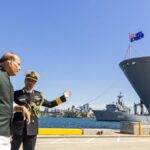India’s recent defence engagement with Australia reached a new milestone during Defence Minister Rajnath Singh’s visit to Canberra and Sydney earlier this month for the inaugural Australia-India Defence Ministers’ Dialogue. The visit, the first by an Indian Defence Minister to Australia in over a decade, produced key defence agreements that upgrade the relationship from declaratory strategic convergence toward greater operational cooperation. The discussions included a Joint Maritime Security Collaboration Roadmap to advance maritime cooperation, as well as renewing and strengthening the Joint Declaration on Defence and Security Cooperation.
Talks also covered an annual Defence Ministers’ Dialogue, an Implementing Arrangement on Mutual Submarine Rescue Support and Cooperation, progress on operationalising the Australia-India Implementing Arrangement on Air-to-Air Refuelling signed in 2024, expanded information-sharing, and the establishment of Joint Staff Talks as a forum to progress joint exercises, operations and interoperability across domains.
A deepening partnership
What makes these outcomes notable is their operational and industrial content. The submarine-rescue arrangement and Joint Staff Talks establish mechanisms for coordinated responses and contingency planning at sea; the air-to-air refuelling implementation and increased interoperability commitments improve tactical reach and combined air operations; and defence-industry round tables and offers by India’s shipyards to support Australian fleet maintenance crystallise a logistics- and sustainment-oriented partnership rather than just high-level signalling. These are practical building blocks that enable more frequent, routinised cooperation across the Indian Ocean and western Pacific littorals.
The India-Australia defence relationship has been evolving in three phases that help explain why this visit mattered.
First, strategic convergence. India and Australia’s shared concerns about China’s unlawful assertions and the health of a rules-based Indo-Pacific have created recurrent diplomatic convergence through the Quad (Australia, India, Japan, United States) and ministerial dialogues. Second, a deepening of operational ties. The last several years saw growing exercise participation, information-sharing and logistics conversations (including bilateral talks on air refuelling and exercises such as Talisman Sabre), which laid the groundwork for devising mechanisms during the current meeting.
Third, industrial and logistics convergence. Both capitals have started looking beyond bilateral exercises to maintenance, defence industry collaboration and securing supply chains, and turning occasional interoperability into longer-term sustenance. The trajectory of the bilateral defence partnership is, hence, evidently moving from warm words to a shared maritime operating model.
The critical reasons
The drivers behind this acceleration are both structural and pragmatic. Structurally, the changing balance of maritime power and Beijing’s more coercive behaviour have incentivised middle powers to reduce operational gaps and create redundancy in defence linkages.
Practically, uncertainties about the reliability of any single external security provider have prompted India and Australia to strengthen their bilateral mechanisms, including logistics support, rescue cooperation and defence industrial ties, thereby reducing the operational friction costs associated with crisis cooperation. The developments concerning AUKUS (Australia, the United Kingdom, and the U.S.) and Australia’s growing access to advanced platforms also created new demand for interoperability with regional partners, which is an opportunity that India can partially fill given its shipbuilding and repair capabilities.
India and Australia’s defence partnership rests on a fusion of complementary strengths — India’s scale and geography with Australia’s technology and innovation. India’s defence production reached a record ₹1.5 lakh crore in FY 2024-25, reflecting the success of its “Make in India” and Innovations for Defence Excellence (iDEX) initiatives that have built a cost-effective, innovation-driven industrial ecosystem.
Its maritime geography, astride vital sea lanes in the Indian Ocean, and growing capabilities in domain awareness, logistics and submarine rescue give India significant regional reach. Australia, meanwhile, complements this with advanced maritime and undersea technologies, including the P-8A Poseidon, MQ-4C Triton, and the “Ghost Shark” autonomous submarine. Supported by strong research and development Canberra brings technological depth and alliance-linked expertise. Together, India’s industrial capacity and cost advantages align with Australia’s high-end systems and innovation, creating a resilient, mutually reinforcing defence relationship. This synergy enhances the ability of both countries to sustain operations, co-develop technologies, and shape a stable Indo-Pacific maritime order.
Political economy and foreign policy signalling also matter. The relationship, initially elevated to a Strategic Partnership in 2009 and further advanced to a Comprehensive Strategic Partnership (CSP) in 2020, rests on a foundation of shared democratic values, expanding economic linkages, and deepening people-to-people connections.
For Canberra, deepening ties with New Delhi diversifies security partnerships in the Indo-Pacific. For New Delhi, Australia is a like-minded partner that can expand India’s reach in the southern Indo-Pacific while bolstering maritime domain awareness and industrial cooperation. At the bureaucratic level, creating annual ministerial and joint staff mechanisms institutionalises the relationship so that cooperation survives political cycles and episodic strategic disruptions.
Looking ahead
The discussions during Mr. Singh’s visit are significant but calibrated while being incremental, reversible and oriented toward interoperability and crisis management rather than binding security guarantees. The following steps to watch would be the pace of implementing logistics and ship-repair arrangements, the depth of classified information-sharing frameworks, concrete defence-industrial joint projects, and how Canberra and New Delhi align these practical ties with broader Quad activity.
If implemented steadily, the arrangements signed during the visit will make India-Australia defence cooperation more routinised, operationally meaningful, and strategically consequential for Indo-Pacific maritime stability.
Harsh V. Pant is Vice-President – Studies and Foreign Policy at the Observer Research Foundation, New Delhi, and Professor of International Relations at King’s College London. Pratnashree Basu is an Associate Fellow, Indo-Pacific, at the Observer Research Foundation
Published – October 20, 2025 12:08 am IST

